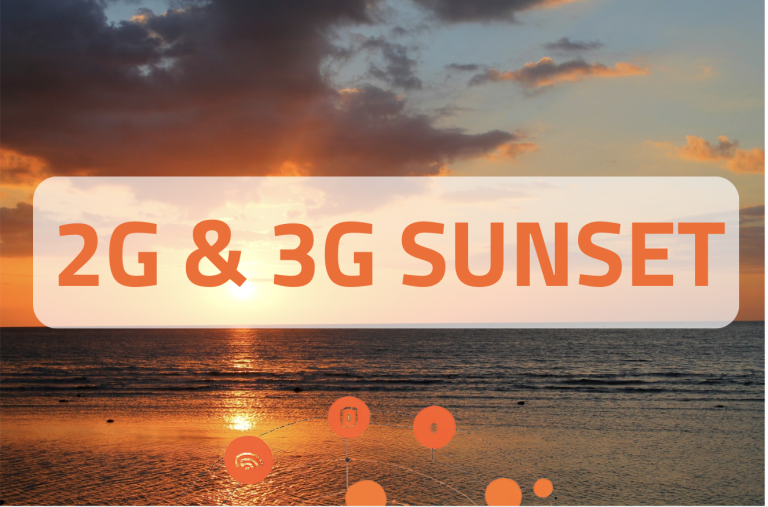Worldwide, billions of IoT devices are still relying on 2G and 3G networks. Meanwhile, operators are gradually phasing out these networks. Explore how you can best prepare and futureproof your IoT deployment.
Some operators have already shut down their 2G and/or 3G networks because of their outdated technology and to create more bandwidth for other networks like 4G and 5G. Luckily, all operators announce their plans much beforehand, so that businesses have time to find alternatives.
In this article we will explain everything you need to know about 2G and 3G sunsets and how to prepare.
What is the reason behind 2G and 3G sunset?
- Network Modernization: Operators are upgrading their infrastructure to support 4G and 5G, which offer higher speeds, lower latency, and greater functionalities using the same frequency bands that 2G and 3G are now operating on.
- Increased Demand for Data: Skyrocketing demand for mobile data requires more efficient networks, which is not supported by legacy technologies like 2G and 3G.
- Cost Efficiency: Older networks have higher maintenance costs as they get older.
- Limited Device Compatibility: Newer devices are not compatible with older network technologies. Market changes necessitate a gradual transition to support newer standards.
- Regulatory and Market Pressure: Governments and market forces influence the transition to higher capacity networks.
Scroll down to find out when the sunset is happening.
What is the effect of the 2G and 3G sunset on your deployment?
Different operators are taking different approaches to the sunset. It’s important to find out which approach the carriers are taking that your deployment is relying on. Some operators are only slowly phasing out their 2G and 3G networks over several years, while others gradually throttle their services as they prepare to implement 4G and 5G technologies. Some operators choose to shut down their networks more abruptly on predefined dates. As operators shut down their services, your devices might be left without connectivity or fallback networks.
Which industries rely most on 2G and 3G?
It’s relevant for any business to evaluate with IoT deployment to assess and evaluate their sunset strategy. Businesses with long-term, low-data IoT deployments heavily deploy 2G and 3G IoT devices, including:
| Industry | Use Cases |
|---|---|
| Agriculture | Remote monitoring of crops, livestock tracking, and environmental sensors. |
| Transportation and Logistics | Fleet management, asset tracking, and vehicle telematics. |
| Utilities | Smart metering in water, gas, and electricity to monitor consumption and detect leaks. |
| Healthcare | Remote patient monitoring, medical equipment tracking, and telehealth applications. |
| Smart Cities | Infrastructure monitoring, waste management, and environmental sensing. |
| Retail | Inventory management, smart shelves, and customer engagement solutions. |
| Security | Alarm systems, surveillance, and remote monitoring solutions. |
How to prepare for the sunset?
Most importantly, act now! It is very time-intensive to test new connectivity solutions and replace or service devices that are deployed in the field. Here’s an overview of what you need to do:
Step 1: Evaluate your devices
• Are they entirely dependent on 2/3G or is it just used as a fallback?
Step 2: Evaluate deployments and customers
• Which deployments and customers need to make a transition?
• Exactly which networks do they operate on?
• What are the individual transition needs per case? Is significant retrofitting needed or does it suffice to switch to a different connectivity service?
Step 3: Create a migration plan
• Create transition timelines for each customer and deployment
How to futureproof your connectivity?
When designing your IoT deployment strategy think long-term and global from the outset. Use multi-network SIM cards that support different technologies and avoid vendor lock-in.
Avoid vendor lock-in through UICC SIM cards or eUICC SIM cards that don’t allow to switch to a different connectivity provider. Our eUICC SIMs, which are configurable over-the-air, allow for more flexibility, as operator profiles and data plans can be changed if the requirements change.
Use multi-network SIM cards, which provide access to multiple networks and multiple network technologies per country. This way, devices can be deployed more flexibly in terms of geographical location, optimal local coverage and flexibility to switch to a different network technology if the device capability allows it. Multi-network sim cards reduce the dependency on the networks of specific operators.
When is the sunset happening?
Globally, networks are being shut down at different intervals depending on the agenda of local regulators and individual operators. The sunset is highly fragment geographically, with some networks already having been decommissioned and others still online for another 5-6 years in countries where the dependency on 2G and 3G is high. Most of Europe is set to phase the technology out by 2025.
| Continent | Phase-Out Summary |
|---|---|
| Africa | No definitive 2G/3G shutdown dates; some networks without service. Limited 2G phase-out in Nigeria by 2025 and South Africa by 2027. |
| Asia | 2G networks mostly phased out; notable shutdowns in East Asia. Ongoing 3G shutdowns expected through 2024-2026. |
| Europe | 2G and 3G phase-outs anticipated mostly by 2025; some operators may retain 2G until 2030. |
| North America | Rapid 2G phase-outs; most complete. 3G shutdowns continuing through 2026-2029. |
| South America | Claro and other networks announcing 2G/3G phase-outs primarily between 2023-2026. |
| Oceania | Most operators have switched off 2G; ongoing 3G shutdowns expected through 2025. |
Partnering with The IoT Guide
Need guidance in shaping your transition towards 4G and 5G? Contact us for more information on the possibilities.

